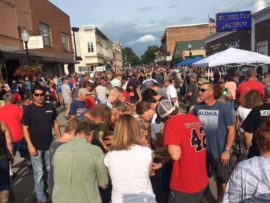
Just what does the weekly Knights of Columbus Treasure Hunt Draw mean to the local economy? That’s what Radius Indiana has been analyzing and in their report the numbers should be enough to get residents, local government and local merchants and businesses excited.
Radius Indiana is an 8 county regional economic development organization that serves Daviess County. They used software in their analysis that was developed by Applied Economics. The model uses inputs and assumptions to give a benchmark number and should be interpreted as a general idea of the impact of tourism events.
In their summary report, Radius says the charitable activity of the K of C raffle has grown to a prominence that it’s providing small but real economic growth to the tourism sector of Washington.
Visitor spending is estimated to be reaching up to $970,000 which creates 14 to 18 full time jobs. Up to nearly $16,000 in additional tax revenue is being added to various local government coffers. Also, each Saturday during the draw, between $385,000 and $481,000 in personal income is being left in the city.
The report was given to the local tourism and visitor’s board Tuesday.
The draw returns after a winter break in April and the estimated jackpot for the first weekend is a quarter-million dollars.
—————
The following is the full report given to the tourism board this week…
Economic Analysis Model of the Impact of K of C Raffle Crowds in
Washington on a Saturday Night
Radius Indiana has prepared an economic impact analysis of the Washington Indiana K of C
raffle drawing, a weekly Saturday night event that has captured the public imagination in southwestern
Indiana over the past two years. This analysis was prepared using software developed by Applied
Economics. The model uses inputs and assumptions to give a benchmark number, and should be
interpreted as a general idea of the impact of tourism events.
The software uses standard assumptions about the spending patterns of visitors who attend
tourism events. Some examples of the assumed spending patterns are a figure of $29.00 per person
spent on food and drink, $28.00 per person spent on entertainment, and $17.00 per person spent on
retail. These figures are based on the 2016 Rockport Analytics report on tourism in Indiana.
This analytic software provides a number of benchmarks that can be used to evaluate the
success of a tourism event, beyond the many intangible benefits a community receives from working
together to host such a festival. The benchmarks that the Radius analysis reports are: estimated jobs
created, estimated personal income gained by the community, total visitor spending, increased property
tax revenues generated by the festival’s impact; local income taxes collected, and lodging tax revenues.
Radius Indiana is an eight-county regional economic development organization that serves
Lawrence and many of the surrounding counties. The principal object of Radius is to support local
economic development organizations, especially by undertaking the marketing of the Radius region to
businesses and business advisors, as well as by providing services that can be most efficiently provided
through cooperative ventures. Also among the core responsibilities of Radius is recognition that tourism
is a key engine of economic activity in the eight county region, and an organizational desire to support
tourism.
Radius Indiana ran the analysis using two possible levels of attendance to show the likely range
of impacts that Washington receives as economic benefits from hosting the unusually popular K of C
raffle. The scenarios used are:
1) A low case of 8,000 visitors
2) A high case of 10,000 visitors
In the low attendance case of an 8,000 visitor scenario, as the approximate lower boundary
number of visitors who are estimated to come to Washington due to the K of C drawing, the analysis
estimates that the visitors spent approximately $776,000 in the Washington area, and create enough
economic activity to justify over fourteen full time employees. The local governments gain $12,551 in
annual property and income tax revenues, and total personal income generated in the community is
$384,796.
Using the higher estimated number of visitors to be 10,000, our model estimates that they
spend $970,000 in Washington, and create enough economic activity to equal eighteen full time
employees in the Washington business community. Total local government revenues are increased by
$15,689 in property and income taxes, and the total additional personal income that is generated is
$480,995.
In summary, the simple, charitable activity of the K of C raffle drawing has grown to have such
prominence that it is providing small but real economic growth to the tourism-related sector of the
Washington economy. The impact is estimated to bring visitor spending between $776,000 and
$970,000 to Washington, creating 14 to 18 full-time jobs in the vicinity, and adding between $12,551
and $15,689 in additional tax revenues to various local government coffers. Finally, each Saturday of
crowds downtown for the K of C raffle is leaving between $384,796 and $480,995 in personal income
in the pockets of the city’s residents.




